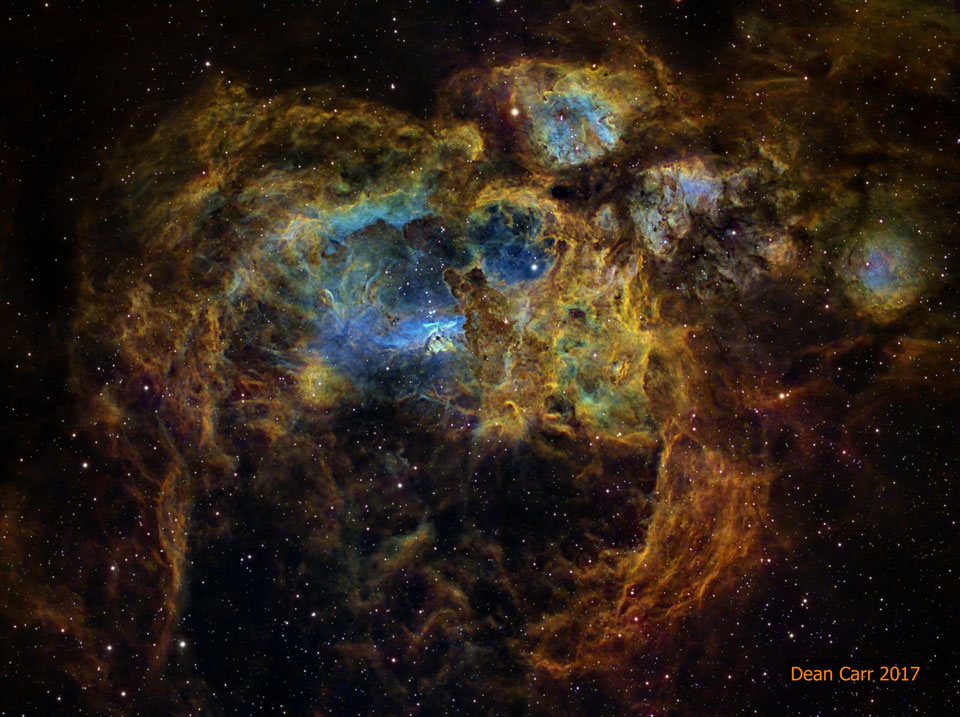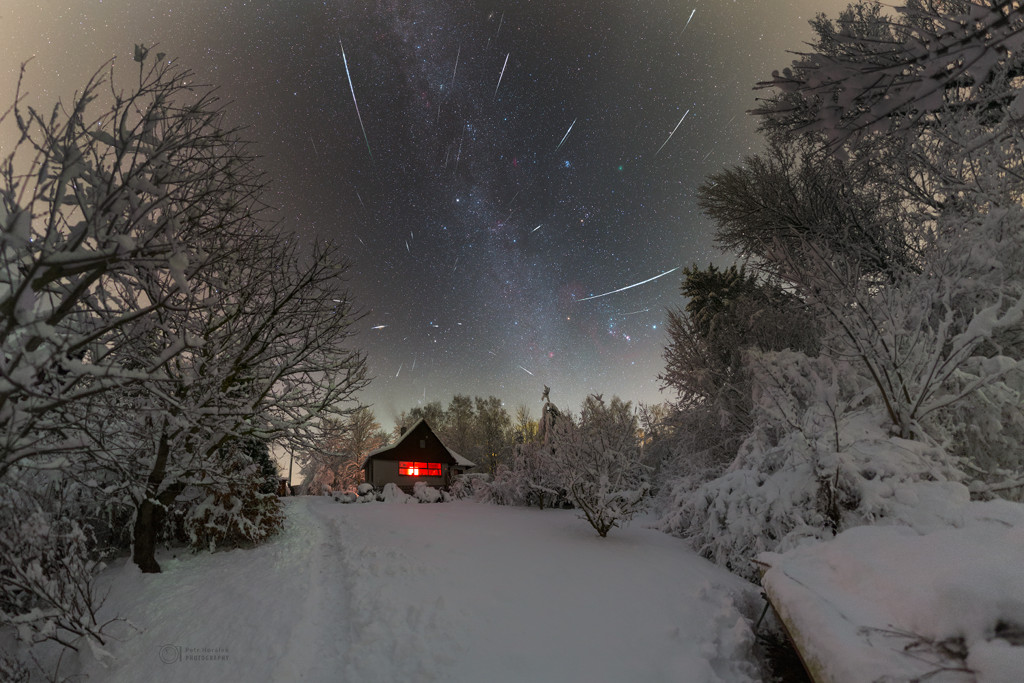Nombre total de pages vues
30/12/2018
29/12/2018
Astronomy picture of the day - 2018 December 29 - New Horizons at Ultima Thule

Explanation: When we celebrate the start of 2019, on January 1 the New Horizons spacecraft will flyby Ultima Thule. A world of the Kuiper belt 6.5 billion kilometers from the Sun, the nickname Ultima Thule (catalog designation 2014 MU69) fittingly means "beyond the known world". Following its 2015 flyby of Pluto, New Horizons was targeted for this journey, attempting the most distant flyby for a spacecraft from Earth by approaching Ultima Thule to within about 3500 kilometers. The tiny world itself is about 30 kilometers in size. This year, an observing campaign with Earth-based telescopes determined the shape of the object to be a contact binary or a close binary sytem as in this artist's illustration. New Horizons will image close up its unexplored surface in the dim light of the distant Sun.
27/12/2018
Astronomy picture of the day - 2018 December 27 - The Great Carina Nebula

Explanation: A jewel of the southern sky, the Great Carina Nebula, also known as NGC 3372, spans over 300 light-years, one of our galaxy's largest star forming regions. Like the smaller, more northerly Great Orion Nebula, the Carina Nebula is easily visible to the unaided eye, though at a distance of 7,500 light-years it is some 5 times farther away. This gorgeous telescopic close-up reveals remarkable details of the region's central glowing filaments ofinterstellar gas and obscuring cosmic dust clouds. The field of view is over 50 light-years across. The Carina Nebula is home to young, extremely massive stars, including the stars of open cluster Trumpler 14 (above and left of center) and the still enigmatic variable Eta Carinae, a star with well over 100 times the mass of the Sun. Eta Carinae is the brightest star, centered here just below the dusty Keyhole Nebula (NGC 3324). While Eta Carinae itself maybe on the verge of a supernova explosion, X-ray images indicate that the Great Carina Nebula has been a veritable supernova factory.
26/12/2018
Découvertes médicales récentes : Un pacemaker pour le cerveau
Les chercheurs ont mis au point un appareil, dont le fonctionnement est similaire à celle d'un stimulateur cardiaque, capable d'améliorer les processus cognitifs des personnes souffrant d'épilepsie, de Parkinson et d'Alzheimer. L'appareil fonctionne en envoyant des impulsions de stimulation profondes aux zones du cerveau et peut également s'adapter à d'autres situations.
Curioctopus - France
Astronomy picture of the day - 2018 December 26 - NGC 6357: The Lobster Nebula

Explanation: Why is the Lobster Nebula forming some of the most massive stars known? No one is yet sure. Cataloged as NGC 6357, the Lobster Nebula houses the open star cluster Pismis 24 near its center -- a home to unusually bright and massive stars. The overall blue glow near the inner star forming region results from the emission of ionized hydrogen gas. The surrounding nebula, featured here, holds a complex tapestry of gas, dark dust, stars still forming, and newly born stars. The intricate patterns are caused by complex interactions between interstellar winds, radiation pressures, magnetic fields, and gravity. NGC 6357 spans about 400 light years and lies about 8,000 light years away toward the constellation of the Scorpion.
24/12/2018
23/12/2018
Photographie - Un incroyable lac glacé photographié sur Mars

Ce lac glacé, situé dans un cratère de 82 kilomètres de large, a été immortalisé par la sonde Mars Express.
Une immense étendue blanche perdue au milieu d'un désert de roches rouges. C'est le spectacle fascinant photographié par la sonde Mars Express, en orbite depuis 2003, et partagé sur les réseaux sociaux par l'Agence spatiale européenne vendredi.
Cette patinoire géante se trouve dans le cratère de Korolev, large de 82 kilomètres et profond de deux kilomètres, dans les basses terres de l'hémisphère nord martien, près de la calotte polaire.
Un "piège froid"
Au centre du cratère, l'épaisseur de glace, quelle que soit la période de l'année, atteint 1,8 kilomètre, explique l'Agence spatiale européenne sur son site. Un phénomène appelé "piège froid" se produit : l'air, refroidi par la glace, s'affaisse et crée un bouclier thermique. "L'air est un mauvais conducteur de chaleur, ce qui exacerbe cet effet et maintient le cratère de Korolev gelé en permanence", écrit l'ESA.
L'Express - France
Astronomy picture of the day - 2018 December 23 - Earthrise: A Video Reconstruction
Explanation: About 12 seconds into this video, something unusual happens. The Earth begins to rise. Never seen by humans before, the rise of the Earth over the limb of the Moon occurred 50 years ago tomorrow and surprised and amazed the crew of Apollo 8. The crew immediately scrambled to take still images of the stunning vista caused by Apollo 8's orbit around the Moon. The featured video is a modern reconstruction of the event as it would have looked were it recorded with a modern movie camera. The colorful orb of our Earth stood out as a familiar icon rising above a distant and unfamiliar moonscape, the whole scene the conceptual reverse of a more familiar moonrise as seen from Earth. To many, the scene also spoke about the unity of humanity: that big blue marble -- that's us -- we all live there. The two-minute video is not time-lapse -- this is the real speed of the Earth rising through the windows of Apollo 8. Seven months and three missions later, Apollo 11 astronauts would not only circle Earth's moon, but land on it.
22/12/2018
Astronomy picture of the day - 2018 December 22 - A Cold December Night

Image Credit & Copyright: Petr Horálek
Explanation: They say Orion always comes up sideways, and he does seem to on this cold December night. The bright stars of the familiar northern winter constellation lie just above the snowy tree tops surrounding a cozy cottage near the town of Ustupky in the Czech Republic. But Gemini's meteors also seem to rain on the wintry landscape. The meteor streaks are captured in exposures made near last Friday's peak of the annual Geminid meteor shower. They stream away from the shower's radiant above the trees, near the two bright stars of the zodiacal constellation of the Twins. Comet Wirtanen, a visitor to planet Earth's skies, is visible too. Look for its telltale greenish coma near the starsof the seven sisters.
Inscription à :
Commentaires (Atom)
ASTRONOMY - NGC 1898: Globular Cluster in the Large Magellanic Cloud
025 December 28 NGC 1898: Globular Cluster in the Large Magellanic Cloud Image Credit: ESA / Hubble & NASA Explanation: Jewels don...

-
2022 September 26 All the Water on Planet Earth Illustration Credit: Jack Cook, Adam Nieman, Woods Hole Oceanographic Institution ; Data ...
-
2025 May 11 The Surface of Venus from Venera 14 Image Credit: Soviet Planetary Exploration Program , Venera 14 ; Processing & Copyri...


